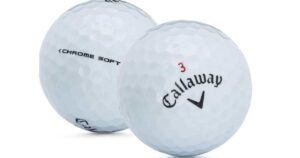Golf balls typically weigh about 45.93 grams or 1.62 ounces. The weight is standardised by golf’s governing bodies. It’s an essential factor in determining a ball’s performance. Heavier balls might travel farther but can be harder to control.Golf balls typically weigh around 45.93 grams (1.62 ounces).
Have you ever wondered, How much do golf balls weigh Well, the answer might surprise you. Golf balls carry a specific weight that’s crucial for the game’s dynamics. Understanding how much golf balls weigh can impact your performance on the course and ensure a fair and consistent experience. Let’s delve into the weighty matter of golf balls and uncover their significance in the world of golf.
Knowing how much golf balls weigh is essential for any golfer. The standard weight is approximately 45.93 grams (1.62 ounces), ensuring fair play and consistent performance on the course. Understanding this weight helps you choose the right ball for your game and maintain a level playing field in golf. Stay with us for more insights into the world of golf!.
Golf Ball Weight and the History of Golf Balls
Golf ball weight has played a significant role in the evolution of golf balls throughout history. Understanding the weight of golf balls is crucial for players to optimize their performance on the course.
The history of golf balls is a fascinating journey, from the early, solid wooden spheres to the high-tech, multi-layered Compress Golf Ball we use today. As weight restrictions have evolved, golf ball manufacturers have developed innovative solutions to meet the demands of players while adhering to regulations.
Weight Restrictions Of A Golf Ball
Weight restrictions are a critical aspect of golf ball design and regulation. Golf’s governing bodies, such as the USGA and R&A, have set specific weight limits for golf balls to maintain a level playing field.
Understanding these restrictions is essential for both amateur and professional golfers to ensure they use conforming equipment. This section will delve into the specific weight limits imposed on golf balls and how they have evolved over time. By adhering to these restrictions, players can compete fairly and preserve the integrity of the sport.
The Heaviest and Lightest Weight of Golf Ball per Brand

Golf ball manufacturers offer a wide range of ball options with varying weights to cater to different player preferences. Some brands produce golf balls on the lighter end of the weight spectrum, while others offer heavier options.
This section will explore the range of golf ball weights available from different brands, giving golfers insights into the diversity of choices to help them find the right ball for their game. By understanding the variations in weight offered by different manufacturers, players can make informed decisions to enhance their performance on the course.
Does the Average Weight of a Golf Ball Change During Golfing?
Once a golf round is underway, golf balls may encounter various conditions and factors that could potentially alter their weight. This section will discuss whether the average weight of a golf ball changes during the course of a round.
Factors like moisture, soil, and even a golf ball’s interaction with the clubface can affect its weight. Understanding these dynamics can help golfers assess the impact of changing conditions on their ball’s performance and adapt their game accordingly.
How the Weight of a Golf Ball Affects Players
The weight of a golf ball can have a significant impact on a player’s performance. In this section, we will explore how the weight of a golf ball influences factors such as distance, control, and feel during a round. Whether you prefer a lighter ball for increased speed or a heavier ball for more control, understanding the effects of weight on your game is essential for maximizing your performance on the golf course.
Final Thoughts on How Much Does a Golf Ball Weight
In the final section of this tutorial, we will summarize the key takeaways regarding golf ball weight. We will discuss the historical evolution of golf ball weight, the impact of weight on a player’s performance, and the diversity of weight options offered by various brands.
By providing a comprehensive overview, we aim to equip golfers with the knowledge they need to make informed decisions about the golf balls they use and improve their game.
What Is The Teeing Ground: Markers & Boundaries
The teeing ground is a fundamental element of golf courses, and understanding its markers and boundaries is crucial for a successful round. In this section, we will explore what the teeing ground is, its designated markers, and the boundaries that define this area. Having a clear understanding of the teeing ground’s rules and dimensions is essential for golfers to start each hole on the right footing.
How High to Tee a Golf Ball
The height at which you tee up a golf ball can significantly impact your game. This section will delve into the considerations for teeing the ball at the right height. Whether you’re aiming for more distance, accuracy, or consistency, knowing how high to tee the ball is an important aspect of your pre-shot routine.
Why Golf Balls Have Dimples: How Do Dimples Help?
Golf balls are covered in dimples, but have you ever wondered why? This section will demystify the purpose of these dimples and explain how they affect a golf ball’s performance. Dimples play a critical role in aerodynamics, affecting the ball’s flight and distance. Understanding the science behind dimples can help golfers appreciate the intricacies of the game.
How To Spin A Golf Ball: Perfecting The Spin Shot
Golfers often seek to master the art of spin shots to control the ball’s movement around the green. This section will provide valuable insights into the techniques and factors that contribute to creating spin with your golf shots. Whether it’s backspin or sidespin, understanding how to make the ball dance on the green can enhance your short game.
The Best Golf Balls for High Handicappers
High handicappers have unique needs when it comes to golf balls. This section will discuss the key features and characteristics that make certain golf balls ideal for players with high handicaps. By choosing the right golf ball, high handicappers can improve their game and enjoy better results on the course.
FAQS
How many grams is 1 golf ball?
A standard golf ball weighs approximately 45.93 grams.
How many golf balls equal a pound?
Around 45 golf balls make up a pound.
How much do 24 golf balls weigh?
24 golf balls weigh about 1.91 pounds.
Is a golf ball heavier?
Heavier than what? Golf balls typically weigh around 1.62 ounces (45.93 grams).
Conclusion
In conclusion, understanding How Much Do Golf Balls Weigh is pivotal for golfers of all levels. The weight of a golf ball, approximately 45.93 grams, impacts various aspects of the game, from distance to control. Choosing the right golf ball weight is essential for optimizing one’s performance on the course.
With advances in golf ball design and materials, players now have a wide range of options, each offering distinct advantages. Finding the ideal weight that suits your playing style and preferences can make a significant difference in your golfing experience. So, whether you’re a beginner or a seasoned golfer, remember that the weight of your golf ball is a critical factor that deserves your attention for a better game.











